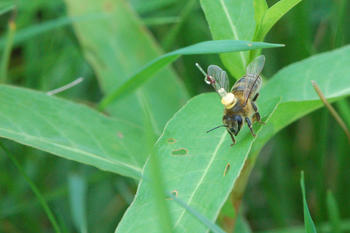Study with new findings on the waggle dance of honeybees published under the leadership of zoologist and neurobiologist Professor Randolf Menzel
News from Mar 28, 2023
According to a recent study, honeybees have a map-like spatial memory of their territory and are able to fly from their starting location to any destination encoded in a waggle dance. These new findings, which offer a radically new perspective on the spatial information contained in the honeybee waggle dance, were published by a research team led by the acclaimed zoologist and neurobiologist at Freie Universität Berlin, Professor Randolf Menzel. It was previously assumed that bees were able to accurately navigate only from their hive to their chosen targets. The study, “Honey Bees Infer Source Location from the Dances of Returning Foragers,” was recently published in the international scientific journal Proceedings of the National Academy of Science (PNAS): https://www.pnas.org/eprint/RUDKWR7KYHM2Z87SMKWI/full
“Bees are able to store the geometric relations between landmarks in their memory and interpret the vector information in the waggle dance so that they can fly from any location within their foraging territory to the location conveyed in the dance,” says Menzel. The new study shows that the dance language of honeybees is much richer and more elaborate than previously thought. The findings also indicate that just like humans, honeybees possess a cognitive map based on geometric information that allows them to navigate from point A to point B within a familiar environment. “We know that they acquire this complex and rich mental map of the terrain during the exploratory flights they carry out as young bees,” Menzel adds.
Fifty years ago the German-Austrian zoologist and behavioral scientist Karl von Frisch (1886–1982) won the Nobel Prize for his work on bees’ waggle dance. Successful foragers inform others in their hive where a food source is located by performing a sequence of rhythmic dance-like movements on a vertical surface inside the hive. They communicate navigational information (direction and distance) through this symbolic form of information transfer. During their flight bees measure the distance using their eyes in two ways. The optical flow (i.e., the pattern of visual motion generated in the eyes of the bees as they fly over terrain) and the number of objects, like trees and other noteworthy local structures they fly by, are factored into their memories. In the waggle dance, each “waggle” equates to eighty meters. Bees measure the direction using their “Sun compass.”
Inside the dark hive, the angle that the bee adopts in their waggle run corresponds to the angle to the Sun they flew on their way to the food source. Because the Sun’s compass direction changes throughout the day, the direction of the waggle run relative to gravity changes accordingly, and the bee uses its time sense to derive the geostable direction. The dancer’s message thus serves as a flight vector to indicate the distance and direction of the flight to a food source. Until now it was assumed that bees who followed the dancer used the message simply as a flying instruction – in other words, that the returning forager was saying “fly this far in this direction from our hive.”
The research team led by Menzel has now proved that bees are not only able to navigate to a location from the hive in which the dance is performed, but can also do so when they start off from another location within their explored territory. For the purposes of the study, the flights of the bees who followed the successful forager’s dance were tracked using a harmonic radar. The bees wore a transponder that read their location every three seconds. A conventional nautical radar transmitted a signal, and the transponder returned the signal with a doubled frequency, which was then captured by a special receiver.
“Bees actually use both the dancer’s vector information and the geographic position they infer from the message for navigation,” says Menzel. The researchers showed that bees also use places they have already explored as a source of information. “By means of our study and our novel approach, we have verified Karl von Frisch’s discovery. What’s more, we have proven that honeybees have a map-like spatial memory that they use in their dance communication,” Menzel adds
Further Information
The study is available online at: https://www.pnas.org/eprint/RUDKWR7KYHM2Z87SMKWI/full
Contact
Prof. Dr. Dr. h.c. Randolf Menzel, Institute of Biology, Freie Universität Berlin, Tel.: +49 (0) 30 838-56537, Email: menzel@neurobiologie.fu-berlin.de

